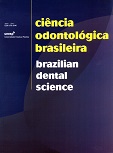Evaluation of extraradicular pH after intracoronal bleaching using four bleaching agents
DOI:
https://doi.org/10.14295/bds.2009.v12i2.331Resumo
The present in vitro study evaluated the pH values of extraradicular medium after intracoronal bleaching with 30% hydrogen peroxide or 10% carbamide peroxide and different associations of sodium perborate. The study was composed of 50 extracted human premolars, randomly divided into five groups, according to the bleaching agent employed for intracoronal bleaching of these teeth: a) distilled water; b) sodium perborate with distilled water (2g/ml); c) sodium perborate with 10% carbamide peroxide (2g/ml); d) sodium perborate with 30% hydrogen peroxide (2g/ml); e) 30% hydrogen peroxide. Coronal access was performed, followed by root canal filling, confection of a cervical intermediate base with resin-modified glass ionomer cement (Vitremer-3M/ESPE) and application of the bleaching agents. The teeth were stored in plastic flasks containing distilled water, using a mechanical device. Measurement of pH of the extraradicular medium (distilled water) was performed immediately and 7 days after insertion of the bleaching agents. The pH values were analysed using the two-way ANOVA and Tukey,s test at significance level of 5%. The results of the present study confirmed the alkalinity of associations of sodium perborate and the acidity of 30% hydrogen peroxide at the immediate period. Considering the results achieved, it can be concluded that the bleaching agents employed changed the pH of the extraradicular medium at 7-day period.
Downloads
Downloads
Publicado
Como Citar
Edição
Seção
Licença
TRANSFERÊNCIA DE DIREITOS AUTORAIS E DECLARAÇÃO DE RESPONSABILIDADE
Toda a propriedade de direitos autorais do artigo "____________________________________________________________________" é transferido do autor(es) para a CIÊNCIA ODONTOLÓGICA BRASILEIRA, no caso do trabalho ser publicado. O artigo não foi publicado em outro lugar e não foi submetido simultaneamente para publicação em outra revista.
Vimos por meio deste, atestar que trabalho é original e não apresenta dados manipulados, fraude ou plágio. Fizemos contribuição científica significativa para o estudo e estamos cientes dos dados apresentados e de acordo com a versão final do artigo. Assumimos total responsabilidade pelos aspectos éticos do estudo.
Este texto deve ser impresso e assinado por todos os autores. A versão digitalizada deverá ser apresentada como arquivo suplementar durante o processo de submissão.




























